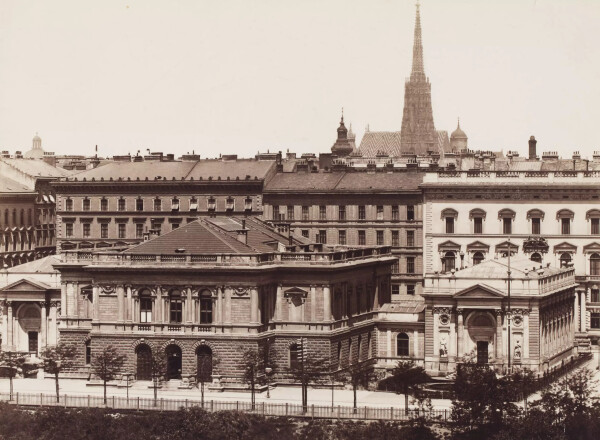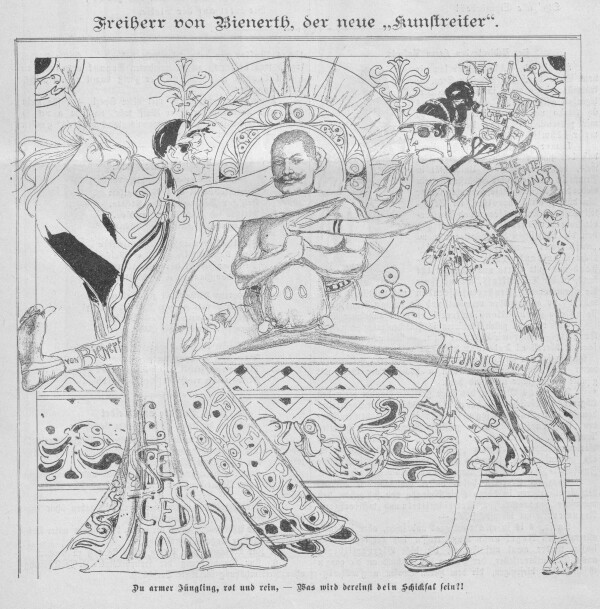Vienna Künstlerhaus

Vienna Künstlerhaus photographed by Leopold Theodor Neumann, around 1875
© Wien Museum
Founded in 1861, the Cooperative of Visual Artists in Vienna was able to move into the specifically built “Künstlerhaus” on Karlsplatz in 1868, which functioned as both a clubhouse and an exhibition venue. Today, it is the oldest artists’ association still existing in Austria.
On 31 January 1861, the Cooperative of Visual Artists in Vienna was founded as a professional association of Vienna’s painters, sculptors, and architects through the merger of the Albrecht Dürer Association and the Eintracht Association. In April, the new cooperative’s statutes were adopted by both associations, and the constituent general assembly took place on 7 November 1861. As a result of the merger, the Cooperative also took over Eintracht’s membership in the General German Art Cooperative – an umbrella organization for all German-speaking artists’ associations. It initially resided at the Dürer Association’s clubhouse, the inn Zum blauen Strauß (No. 25 Gumpendorfer Straße), but planned to move into a building of its own.
As the Cooperative was recognized as the monarchy’s only body representing the interests of artists at the time, the state authorities entrusted it with such tasks as organizing state exhibitions and Austrian art sections at World’s Fairs, conducting negotiations on copyright protection, dispatching experts, etc. Specialized groups and subsidiary organizations such as the Society of Young Architects, the Architects’ Club, the Watercolourists’ Club, and the Sculptors’ Club were formed within the Cooperative to represent all of Vienna’s visual artists. There were also other purely social organizations such as a marksmen’s guild, as well as clubs for ninepin bowling, billiards, tarot, and cycling.
Clubhouse
The “Künstlerhaus” was the first exhibition building and clubhouse in the entire German-speaking world to be built by artists themselves. As part of the Ringstraße expansion, the site near the Wien River was donated by the Emperor, and the building was financed by a network of donors and founders. The foundation stone was laid on 21 August 1865, and the building was constructed based on plans by August Weber between Akademiestraße and Bösendorferstraße, with the front facing the Wien River, in the style of an Italian Renaissance villa. The building was inaugurated in the presence of Emperor Francis Joseph I on 1 September 1868 with the opening of the “III. Allgemeine Deutsche Kunstausstellung” [“3rd General German Art Exhibition”] of the General German Art Cooperative.
The Künstlerhaus served primarily as an exhibition building, but in addition to representing the interests of its members, the cooperative also organized artists’ parties and the famous “Gschnasfeste” [fancy dress balls]. From the very beginning, the building was also rented by art dealers and gallery owners such as Miethke & Wawra, Peter Kaeser, and Charles Sedelmeyer for prestigious auctions. During the Gründerzeit in particular, the Künstlerhaus increasingly became the venue of spectacular, profit-oriented exhibitions, which contemporaries sometimes sneeringly compared to fairground attractions.

Caricature of Minister of Education Richard Bienerth with the Association, the Hagenbund and the Künstlerhaus, in: Figaro, 14.10.1905.
© ANNO | Austrian National Library
Secession and Hagenbund
The role as an intermediary between the public and artists, as well as the Cooperative’s national and international customer contacts were important economic aspects for membership. From the early 1890s, a number of young artists like Carl Moll, Gustav Klimt, Kolo Moser, and Josef Hoffman joined. Klimt became a member of the Cooperative in 1891 and obtained important commissions through the Künstlerhaus, such as those from collector Nicolaus Dumba. Moll joined as early as 1890 and was on the board from 1894, when he initiated the organization of the exhibition of the Munich Secession and the Free Association of Düsseldorf Artists. This groundbreaking exhibition opened in December 1894, with Franz von Stuck among the German Secessionists who presented their works in Vienna.
Moll was one of the driving forces behind the renewal of the Künstlerhaus. However, the exhibition policy and differing views on modern ideas led to tensions within the conservative institution. A group of artists within the cooperative, the already existing Hagengesellschaft and the so-called Siebener-Club [Club of the Seven], including Rudolf Bacher, Wilhelm Bernatzik, Josef Engelhart, Gustav Klimt, Carl Moll, Kolo Moser, Anton Nowak, and Alfred Roller, formed the Association of Austrian Artists Secession in 1897. Klimt, Moser, Moll, Hoffmann and Joseph Maria Olbrich were among the best-known founding members, who above all criticized the “show booth character” of the frequently overloaded Künstlerhaus exhibitions, wishing to create modern art on the basis of new principles.
The “affair” surrounding Josef Engelhart’s naturalistic female nude The Cherry Picker (1893, destroyed in World War II) is also often given as a reason for the split. The Cooperative’s jury initially rejected the painting “out of consideration for convention” and due to moral concerns, but nevertheless exhibited it at the Künstlerhaus in 1894 after Engelhart’s objection, and the painter later described the events as the “quiet beginning of a movement” that “led to the founding of the Secession.”
As a result of the installation of the Secession, the Künstlerhaus lost its function as the sole representative of the interests of Viennese artists. As some members of the Hagengesellschaft were refused admission to the Secession, they for their part founded the Hagenbund in 1899 as a subsidiary of the Cooperative of Visual Artists in Vienna and finally left the latter for good in 1900.
War and Postwar Period
The Künstlerhaus continued to lose importance and in 1912, following a change in its statutes, left the General German Art Cooperative. After the outbreak of World War I in 1914, the clubhouse was made available to the Austrian Red Cross as a convalescent home until the last soldiers would finally leave in late 1918.
In the 1920s, the Künstlerhaus became increasingly open to modern artistic developments in Austria. In 1939, the Secession was integrated into the association now called the Society of Visual Artists in Vienna, Künstlerhaus. During World War II, the building was used by the Wehrmacht as a granary.
The once leading role of the Künstlerhaus remained weakened even after the war, given the numerous newly established artists’ associations.
Literature and sources
- K.: Das Künstlerhaus in Wien. Von Architekt August Weber, in: Allgemeine Bauzeitung, 1881, S. 67-68.
- Oskar Pausch: Gründung und Baugeschichte der Wiener Secession. Mit Erstedition des Protokollbuches von Alfred Roller, Vienna 2006.
- Christian Huemer: Jahrmarktbude oder Musentempel? Das Wiener Künstlerhaus und der Kunsthandel, in: Peter Bogner, Richard Kurdiovsky, Johannes Stoll (Hg.): Das Wiener Künstlerhaus. Kunst und Institution, Vienna 2015, S. 267–275.
- Wien Geschichte Wiki. Künstlerhaus. www.geschichtewiki.wien.gv.at/K%C3%BCnstlerhaus (04/14/2020).
- Künstlerhaus. Geschichte. www.k-haus.at/de/kuenstlerhaus/geschichte/ (04/14/2020).
- Wladimir Aichelburg: Das Wiener Künstlerhaus. 125 Jahre in Bilddokumenten, Vienna 1986.
- Wladimir Aichelburg: Das Wiener Künstlerhaus 1861–2001, Band 1, Vienna 2003.
- Rudolf von Eitelberger: Öffentliche Kunstpflege, in: Kunst und Kunstgewerbe auf der Wiener Weltausstellung 1873, Leipzig 1875, S. 273.
- Patrick Fiska, Holger Englerth: Ohne Klimt. Klimt und das Künstlerhaus, in: Peter Bogner, Richard Kurdiovsky, Johannes Stoll (Hg.): Das Wiener Künstlerhaus. Kunst und Institution, Vienna 2015, S. 277-283.

